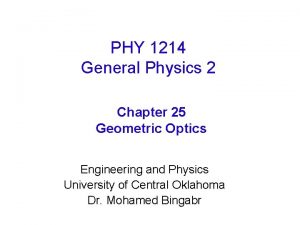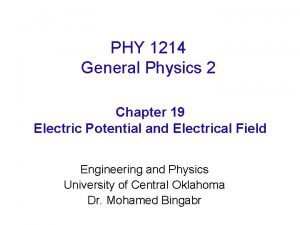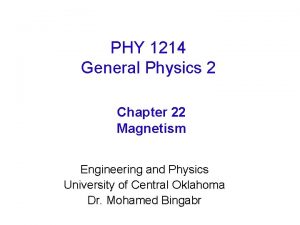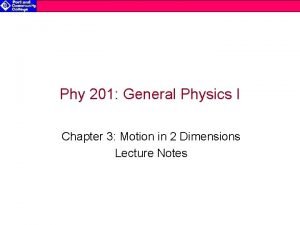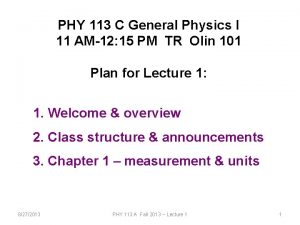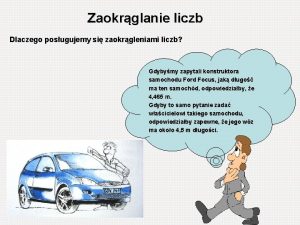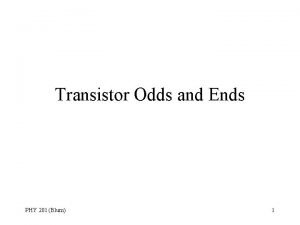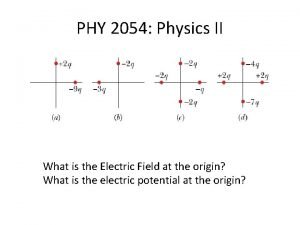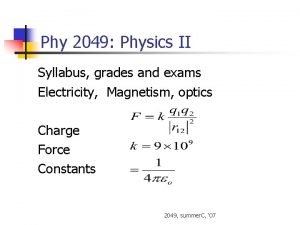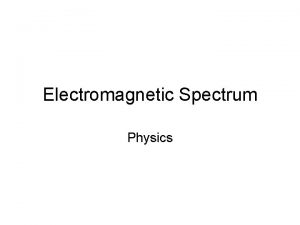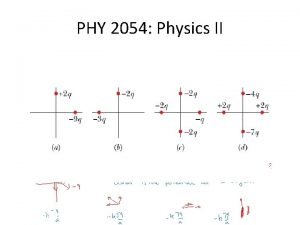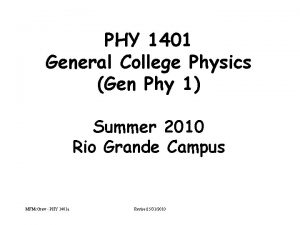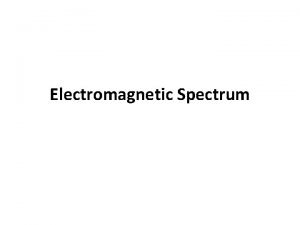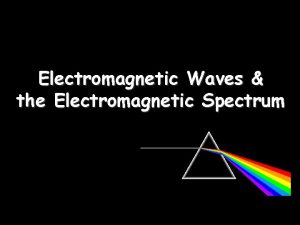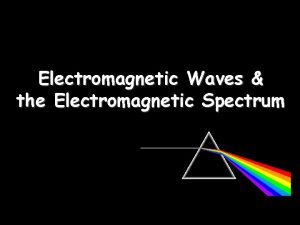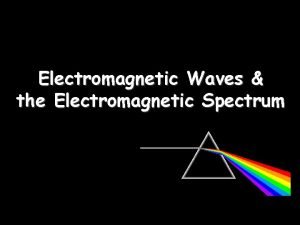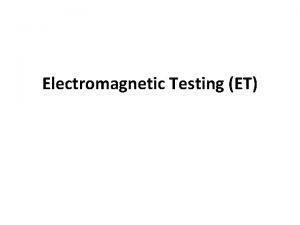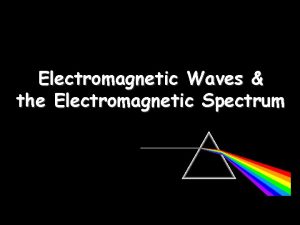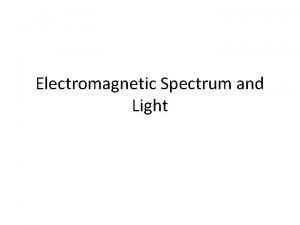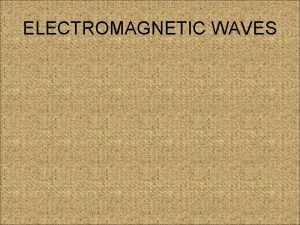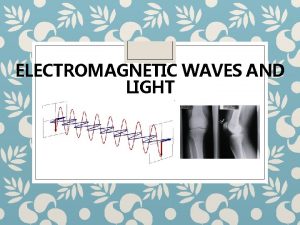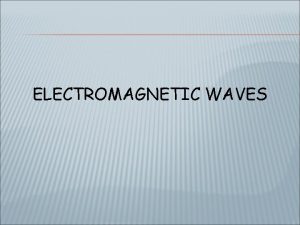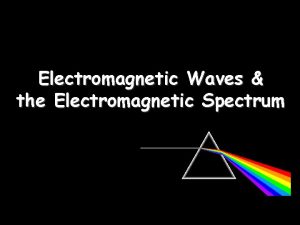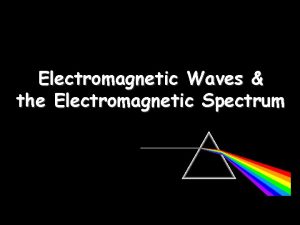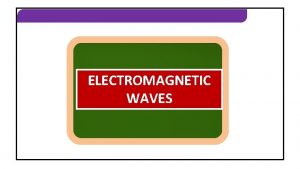PHY 1214 General Physics 2 Chapter 23 Electromagnetic


























- Slides: 26

PHY 1214 General Physics 2 Chapter 23 Electromagnetic Induction Engineering and Physics University of Central Oklahoma Dr. Mohamed Bingabr

Chapter Outline • Induced Emf and Magnetic Flux • Faraday’s Law of Induction: Lenz’s Law • Motional Emf • Eddy Currents and Magnetic Damping • Electric Generators • Transformers • Inductance • RL and RLC Circuits

Electromagnetic Induction is the process of generating voltage and current from magnetic field. Faraday’s apparatus for demonstrating that a magnetic field can produce a current. A change in the field produced by the top coil induces an emf and, hence, a current in the bottom coil. When the switch is opened and closed, the galvanometer registers currents in opposite directions. No current flows through the galvanometer when the switch remains closed or open.

Magnetic Flux ϕ

Generator is a device that generate electricity from mechanical motion. Rotation of a coil in a magnetic field produces an emf. This is the basic construction of a generator, where work done to turn the coil is converted to electric energy. Note the generator is very similar in construction to a motor.

Faraday’s Law of Induction: Lenz’s Law Unit of emf is volt

Application of Faraday’s Law Cochlear Implant: Helping the deaf to hear again.

Calculating Emf Ex. : The magnetic field between the poles of the electromagnet is uniform at any time, but its magnitude is increasing at the rate of 0. 02 T/s. The area of the conducting loop in the field is 120 cm 2, and the total circuit resistance, including the meter, is 5 Ω. Find the induced emf and the induced current in the circuit.

Motional Emf Motion in a stationary uniform magnetic field produces motional emf.

Magnetic Field Strength & Force in a Charge Ex. : The length of the moving rod is 0. 1 m, the velocity v is 2. 5 m/s, the total resistance of the loop is 0. 03 Ω, and B is 0. 6 T. Find the motional emf, the induced current, and the force acting on the rod.

Eddy Currents and Magnetic Damping (a) The motion of a metal pendulum bob swinging between the poles of a magnet is quickly damped by the action of eddy currents. (b) There is little effect on the motion of a slotted metal bob, implying that eddy currents are made less effective. (c) There is also no magnetic damping on a nonconducting bob, since the eddy currents are extremely small.

Eddy Currents and Magnetic Damping A more detailed look at the conducting plate passing between the poles of a magnet. As it enters and leaves the field, the change in flux produces an eddy current. Magnetic force on the current loop opposes the motion. There is no current and no magnetic drag when the plate is completely inside the uniform field.

Application of Eddy Currents An airport metal detector and a portable metal detector, both of which use eddy currents in their design.

Electric Generators The generator coil shown below is rotated through one-fourth of a revolution (from θ = 0 to θ = 90) in 15. 0 ms. The 200 -turn square coil has a side length 5. 00 cm and is in a uniform 1. 2 T magnetic field. What is the average emf induced?

Electric Generators A generator with a single rectangular coil rotated at constant angular velocity in a uniform magnetic field produces an emf that varies sinusoidally in time. + > > - Coil with N turn +

Electric Generators

Electric Generators Ex: Consider a motor with a square, 500 turn coil 10 cm on a side. If the magnetic field has magnitude 0. 2 T, at what rotation speed is the maximum emf of the motor equal to 112 V?

Transformers: transform voltages from one value to another.

Transformers A typical construction of a simple transformer has two coils wound on a ferromagnetic core. The magnetic field created by the primary is mostly confined to and increased by the core, which transmits it to the secondary coil. Any change in current in the primary induces a current in the secondary.

Transformers Ex 23. 5: A portable x-ray unit has a step-up transformer, the 120 V input of which is transformed to the 100 k. V output needed by the x-ray tube. The primary has 50 loops and draws a current of 10. 00 A when in use. (a) What is the number of loops in the secondary? (b) Find the current output of the secondary.

Transformers Ex 23. 6: A battery meant for a series connection of ten nickel-cadmium batteries (total of 12. 5 V DC) needs to have a 15. 0 V output to charge the batteries. It uses a step-down transformer with a 200 -loop primary and a 120 V input. (a) How many loops should there be in the secondary coil? (b) If the charging current is 16. 0 A, what is the input current?

Electrical Safety: Systems and Devices Electrical Safety: - Thermal Hazard - Shock Hazard

Inductance Induction is the process in which an emf is induced by changing magnetic flux. Mutual Inductance is the effect of Faraday’s law of induction for one device upon another, such as the primary coil in transmitting energy to the secondary in a transformer. M: Mutual Inductance (unit H, henry)

Inductor Self Inductance (L): When the current through a coil is increased, the magnetic field and flux also increase, inducing a counter emf, as required by Lenz’s law. Energy stored Ex. 23. 7: Calculate the self-inductance of a 10. 0 cm long, 4. 00 cm diameter solenoid that has 200 coils. How much energy is stored in the inductor when 30. 0 A current flows through it? Ans: L = 0. 632 m. H Eind = 0. 284 J

RL Circuits Discharging Mode (Position 2) Charging Mode (Position 1) Characteristic time constant (a) An RL circuit with a switch to turn current on and off. When in position 1, the battery, resistor, and inductor are in series and a current is established. In position 2, the battery is removed and the current eventually stops because of energy loss in the resistor. (b) A graph of current growth versus time when the switch is moved to position 1. (c) A graph of current decay when the switch is moved to position 2.

RL Circuits Ex. 23. 9: (a) What is the characteristic time constant for a 7. 5 m. H inductor in series with a 3. 00 Ω resistor? (b) Find the current 5. 00 ms after the switch is moved to position 2 to disconnect the battery, if it is initially 10. 0 A.
 General physics
General physics Phy 1214
Phy 1214 Phy 1214
Phy 1214 General physics chapters
General physics chapters Vx=vox+axt
Vx=vox+axt Phy 1214
Phy 1214 Zaokrąglanie do setek
Zaokrąglanie do setek 1214 battaglia di bouvines
1214 battaglia di bouvines 1214 no tenemos a los cobardes
1214 no tenemos a los cobardes Year 1214
Year 1214 Phy 131 past papers
Phy 131 past papers Phy 231 msu
Phy 231 msu Great orthogonality theorem in group theory
Great orthogonality theorem in group theory Phy 221 msu
Phy 221 msu Phy theorem
Phy theorem Phy113
Phy113 Phy 131 asu
Phy 131 asu Ddr phy architecture
Ddr phy architecture Phy 205
Phy 205 Eyephy
Eyephy Phy 2049
Phy 2049 Phy
Phy Phy
Phy Phy
Phy Atm packet phy
Atm packet phy Phy
Phy Phy 2049
Phy 2049
